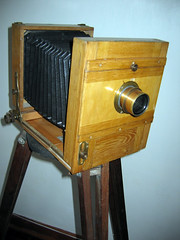Photography is the result of combining several technical discoveries, says Wikipedia. Long before the first photographs were made, Chinese philosopher Mo Ti described a pinhole camera in the 5th century B.C.E,[1] Ibn al-Haytham (Alhazen) (965–1040) studied the camera obscura and pinhole camera,[1][2]
Albertus Magnus (1139-1238) discovered silver nitrate, and Georges Fabricius (1516-1571) discovered silver chloride. Daniel Barbaro described a diaphragm in 1568.
Wilhelm Homberg described how light darkened some chemicals (photochemical effect) in 1694. The fiction book Giphantie (by the French Tiphaigne de la Roche, 1729-1774) described what can be interpreted as photography.
The camera obscura did not record an image, but projected images from an opening in the wall of a darkened room onto a surface, turning the room into a large pinhole camera. The phrase camera obscura literally means dark chamber.
The first permanent photograph was an image produced in 1825 by the French inventor Joseph Nicéphore Niépce on a polished pewter plate covered with a petroleum derivative called bitumen of Judea. Produced with a camera, the image required an eight-hour exposure in bright sunshine.
In 1839 Louis Daguerre announced that he had invented a process using silver on a copper plate called the daguerreotype.
By 1840, William Henry Fox Talbot had invented the calotype process. He coated paper sheets with silver chloride to create an intermediate negative image. Unlike a daguerreotype, a calotype negative could be used to reproduce positive prints, like most chemical films do today. Talbot patented[7] this process, which greatly limited its adoption.
The daguerreotype proved popular in responding to the demand for portraiture emerging from the middle classes during the Industrial Revolution.[citation needed] This demand, that could not be met in volume and in cost by oil painting, added to the push for the development of photography.
Tuesday, December 16, 2008
Subscribe to:
Post Comments (Atom)





No comments:
Post a Comment